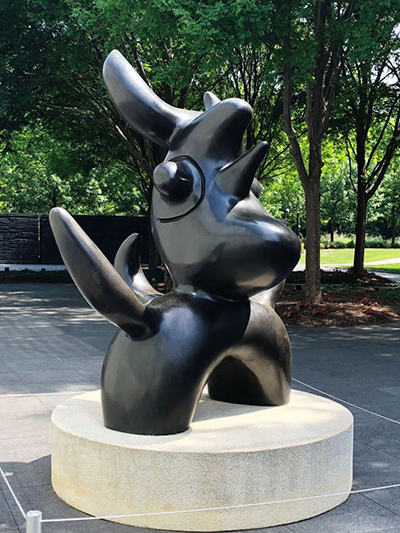Oiseau lunaire is sometimes known as either Moon bird or Lunar Bird. This design has been through several different versions and adaptations, as is often the case within this art discipline.
Joan Miro put together the initial work for this project in the mid-1940s. There are several different versions of the design now in existence, with bronze sculptures to be found in the Hirshhorn Museum and Sculpture Garden in Washington DC, USA and also another at the Reina Sofia Museo Nacional Centro de Arte, Spain. Jean Arp was an artist of around that time that inspired Miro and it is believed that much of the style of Lunar Bird was directly from that. Miro himself would regularly spend time with other artists and earlier in his career that had brought about series of paintings in the Cubist and Surrealist styles. Later on he decided to challenge himself even further, hence his move outside of the painting bubble into entirely different mediums. The moon and general cosmology theme was very much an element of Miro's career, though, and so the content feels like a natural progression within his life.
He would take design icons and then transfer across into different mediums, somehow able to make them continue to work in entirely different materials. Miro would, however, call upon support from specialists when heading out of his comfort zone of oil painting in order to avoid having to spend years learning the perculiarities of each new medium. Another notable piece in which Miro took on advice and assistance from others was his highly memorable Dona i Ocell, which also took on elements which were commonly found in the latter half of his career. That sculpture differs considerably from what we see in Lunar Bird - with alternative materials, colours and size - this was an artist who liked to re-invent himself time and time again.
The initial moulding was completed entirely by Miro, and he worked without any real preparation at all. He would already have had the various shapes in his mind from previous paintings, and set about creating a three dimensional version of this theme. It was then much later in the 1960s that the mould was cast in bronze and this is what exists today. Its size means it is much more suitable for an outdoor display, though we do know that the artist produced a good variety of different sized sculptures within his career. Others could be easily displayed indoors, with later pieces being up to 22 metres in height. He studied sculpture as a young student and so an interest in the medium was there from an early age, though he did not act on it until his paintings were highly evolved.




